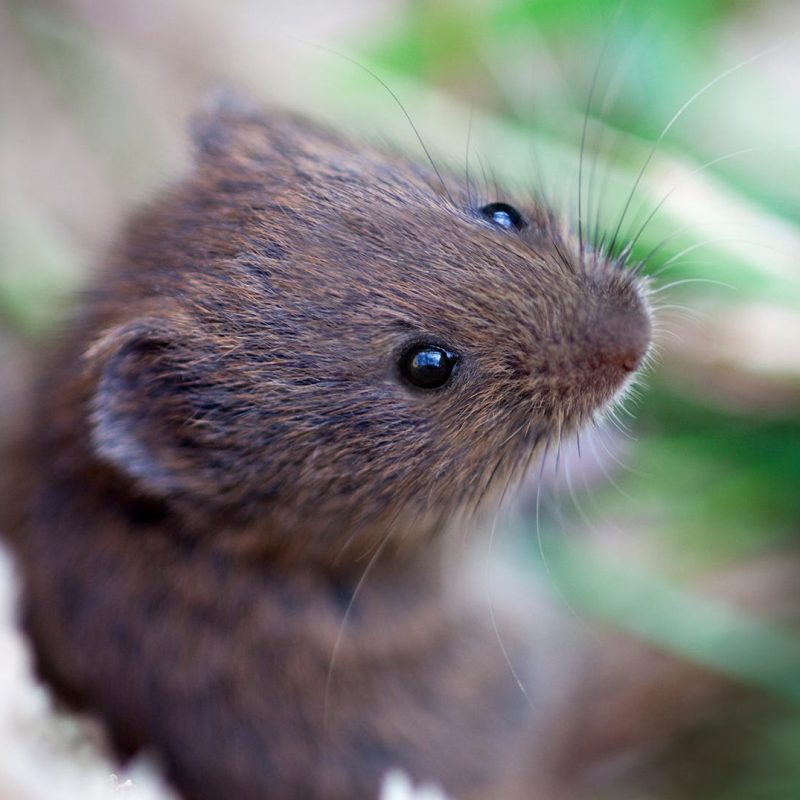The warm winter has meant more activity from the moles and voles. Our yard is riddled with evidence that they are in full occupation! These pesky little subterranean critters can wreak havoc on your yard and chances are, if you have a healthy, happy lawn or garden, these critters will think so too and move right in. Which critter you have can be easily identified by the indicator you’ll see on the surface.
Moles are brown or grey mammals and live almost exclusively underground and you will rarely spot one on the surface but you will know that you have moles by the mounds of dirt you see piled up all over your yard. While they pose no threat to gardeners, they can destroy a lawn with their mounds. Since moles eat earthworms and grubs and since the are voracious eaters, their day consists of a never ending search for more food as they dig tunnels on this quest. Some gardeners actually view moles as beneficial since their activity loosens compacted soil and helps control the grub population in the area. If the tunnels in your yard appear to be raised, then you have moles. If they are are not, then you may have a pocket gopher infestation. Close cousins of the moles, you can tell them apart because moles have small teeth and hardly any eyes to speak of. Pocket gophers have very large teeth and eyes that are easy to spot.
Voles are small, mouse like rodents that resemble mice. You will know that you have voles in your yard by the network of 2″ wide tunnels that are visible from the surface. Although they are subterranean they do not burrow deeply as moles do which is why their tunnels are easy to spot. These nocturnal critters feed exclusively on plant material such as grasses, vegetables, bulbs, roots, and the bark of your trees during the winter which can be devastating to your plants and landscape as they quietly eat away. They are particularly fond of fruit trees, so if you have an orchard, be sure to check it often for tell tale signs of these visitors. Voles have a very short lifespan of about 16 months, but make up for it by being prolific breeders. They can produce up to 30 offspring annually and will do so in short, three week intervals.
If you have either of these furry friends in your garden, you’ll want to control them quickly and there are several ways to do that.
Traps are the quickest and surest way to know that you’ve eliminated your guests because you’ll be able to see them in the trap. Before setting traps, be sure that you have located an active tunnel and you can do this by covering the area with some loose soil. If it is cleared away within a few days then you can set your trap. In the case of voles, tamp the tunnels down and then watch to see which ones reemerge within a few days.
Natural predators like the family cat, can be quite effective as well. Since cats love to hunt and are often proud to show off their prey, populations are often controlled by letting the family pet out to do what they do best. You can also encourage other natural predators such as owls and hawks by providing perching areas right in the middle of your infested field. The birds will love it and your problems could well disappear quickly!
Repellants are another way to try to relocate them away from your yard. Castor oil is sometimes effective, or you can purchase commercial repellants such as Repels-All at the garden center that work quite well. The trick to using repellants is to use them consistently and often, because once the smell is gone, the critters often move back in. Neem oil can work too. Since this organic control works to eliminate the grubs that are their food source, if you get rid of the grubs, you’ll get rid of the moles.
If none of these work, try putting down a barrier. Wire cloth, mesh, chicken wire, or fencing can be good deterrents.
Although no one likes to use them, poisons may be necessary as a last resort. Some people have also had success by simply flooding the tunnels with water and sending the message that your yard isn’t a friendly place to live.
No matter which method you choose to control these unwanted guests, you’ll want to eliminate them quickly to protect your garden and landscaping this spring.

